Africa is the worlds second-largest continent with 54 countries and a land of incredibly diverse peoples, landscapes and histories. From the scorching heat of the desert to the lush green humid rainforests, Africa is home to a variety of animals and plants. Natural landmarks in Africa range from mountains to rock formations, rivers and waterfalls.
As a continent, Africa has seen many powerful empires make their mark, including the Pharaohs of Ancient Egypt, the Romans and the Ancient Greeks. Africa is the cradle of mankind, with evidence of the first humans marked on its landscape. If you are planning a trip to this magnificent continent, here are 20 landmarks in Africa you cannot miss.
Contents
- 20 Incredible Landmarks in Africa
- Natural Landmarks in Africa
- 1- Mount Kilimanjaro – Tanzania
- 2- Table Mountain – South Africa
- 3- Victoria Falls – Zambia and Zimbabwe
- 4- Okavango Delta – Botswana
- 5- Olduvai Gorge – Tanzania
- 6- Aloba Arch – Chad
- 7- Zuma Rock – Nigeria
- 8- Avenue of Baobabs – Madagascar
- 9- Mount Nyiragongo – Democratic Republic of the Congo
- 10- Skeleton Coast – Namibia
- 11- Mara River – Kenya
- Historic Landmarks in Africa
- Natural Landmarks in Africa
20 Incredible Landmarks in Africa
Natural Landmarks in Africa
1- Mount Kilimanjaro – Tanzania
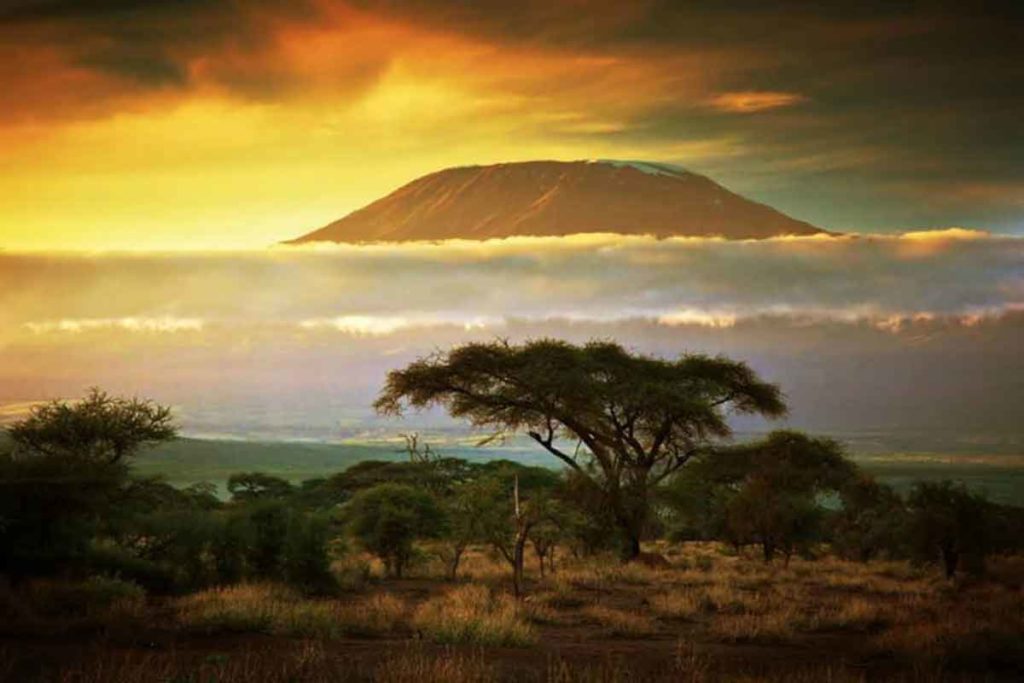
Mount Kilimanjaro in Tanzania is Africa’s tallest peak and stands at 5895 m above sea level.
Unusually, it stands alone rather than as part of a mountain range, as it was formed during volcanic activity.
Mount Kilimanjaro was formed from three volcanoes, one of which is dormant, so could one day erupt.
Climbing Mount Kilimanjaro will take climbers through five ecological zones, from bushland towards the foot of the mountain to an almost arctic climate at the summit.
Kilimanjaro is topped by a glacier, however, due to global warming, the glacier has shrunk by more than 82% since 1912.
2- Table Mountain – South Africa

Table Mountain, one of the New Seven Wonders of the World, watches over Cape Town in South Africa.
The mountain’s famous flattened peak, a 3km plateau, was once the base of an ancient valley.
The mountain is famous for its many species of flora and fauna and supports many endangered plants including Peninsula Sandstone Fynbos and Afromontane forests.
A cable car is available to take visitors to Table Mountain’s peak, however, walking routes are also available.
The views from the top, no matter how you ascend, are however striking.
3- Victoria Falls – Zambia and Zimbabwe
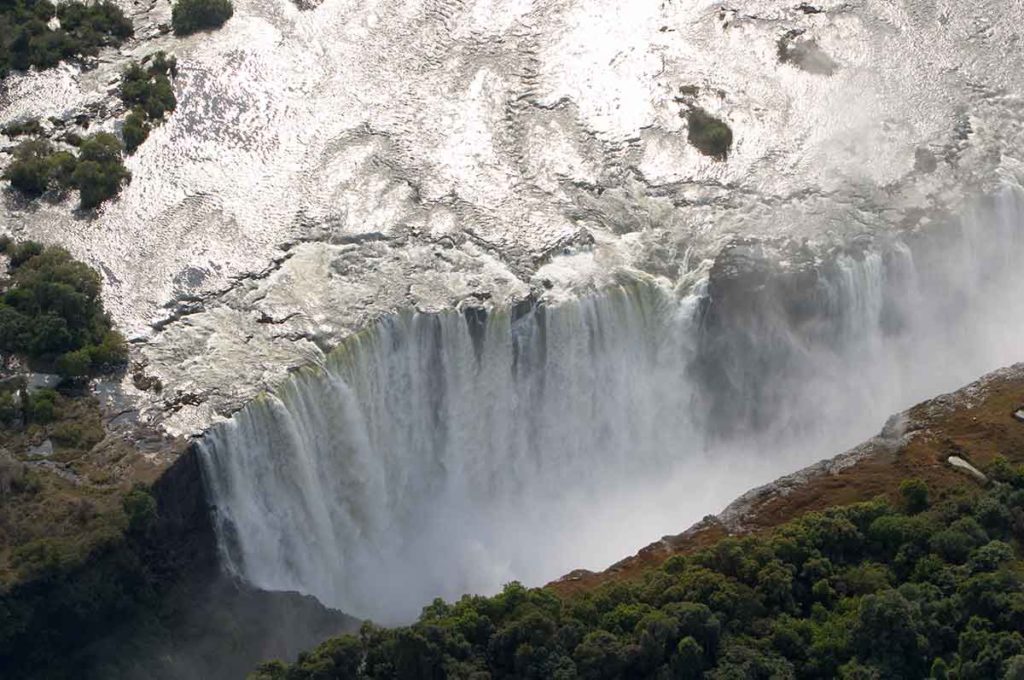
Forming the border between Zambia and Zimbabwe on the Zambezi River is Victoria Falls, an awe-inspiring waterfall known today as the ‘greatest curtain of falling water in the world’.
The falls cascade over a sheer cliff of basalt, and due to the gorges narrow form, the opposite basalt cliff benefits from the sprays and mist caused by the falls to nourish its rainforest environment.
Victoria Falls are visible from many vantage points. For the most famous and breathtaking view, head to Knife-Edge Bridge.
4- Okavango Delta – Botswana
The Okavango Delta in north-west Botswana is a marshland which floods seasonally due to the River Okavango.
The delta is vast, covering approximately 2,023,590 hectares within the World Heritage property.
The unique ecosystem here allows the delta to support many endangered species of animals such as African wild dogs, white and black rhinoceros, and lions.
The animals in the delta have evolved to be biologically synchronised with the deltas seasons by heading to the flooded plains during the rainy season.
The Okavango Delta is popular with safari tours, where tourists have the chance to experience the delta and the incredible animals up close.
5- Olduvai Gorge – Tanzania
Within the Serengeti National Park is Olduvai George, a site that holds the earliest evidence of human existence.
The gorge was created through both volcanic eruptions and plate tectonics and has been eroded to its current state over millions of years.
The gorge and immediate surrounding area have been extensively excavated by paleoanthropologists, who found stone tools and fossilised bones dating back millions of years, which added to the conclusion that human life evolved in Africa.
6- Aloba Arch – Chad
A magnificent natural phenomenon, the Aloba Arch in Chad stands at nearly 400 feet high, and 250 feet wide.
The arch is in the Sahara Desert, in the Ennedi Range.
The arch is formed from sandstone and is believed to have formed in two stages, possibly eroded by an ancient stream that once ran through the valley.
The arch is not often visited due to its remote location and therefore provides photographers with uninterrupted views of this spectacular natural landmark.
7- Zuma Rock – Nigeria
Looming over Nigeria at 725 m high is Zuma Rock, an imposing natural rock formation surrounded in myths and legends.
One such legend is that of the human face. The rocks are formed in such a way that they resemble a human face.
This realisation led the Gwari people to believe that the rock is the gateway to the afterlife.
Another legend is that the rock represents a powerful deity, with the Zuba people in the 15th-century offering sacrifices to Zuma Rock to protect them from evil spirits.
The rock is featured on the 100 Naira note and is twice as high as Uluru in Australia.
8- Avenue of Baobabs – Madagascar
A simple dirt track connecting Morondava to Belo Tsiribihina in Madagascar is a spectacular natural landmark due to its ancient trees.
Lining the track are dozens of ancient and rare baobab trees, many of which are more than 800 years old.
The trees are a spectacular sight, with thick, branchless trunks topped with stretching root-like canopies which are making the most of the sunlight.
This avenue is however not just a spectacular natural sight.
The trees can be tapped for water during dry seasons, without causing any lasting damage, and their leaves and fruits are edible.
9- Mount Nyiragongo – Democratic Republic of the Congo
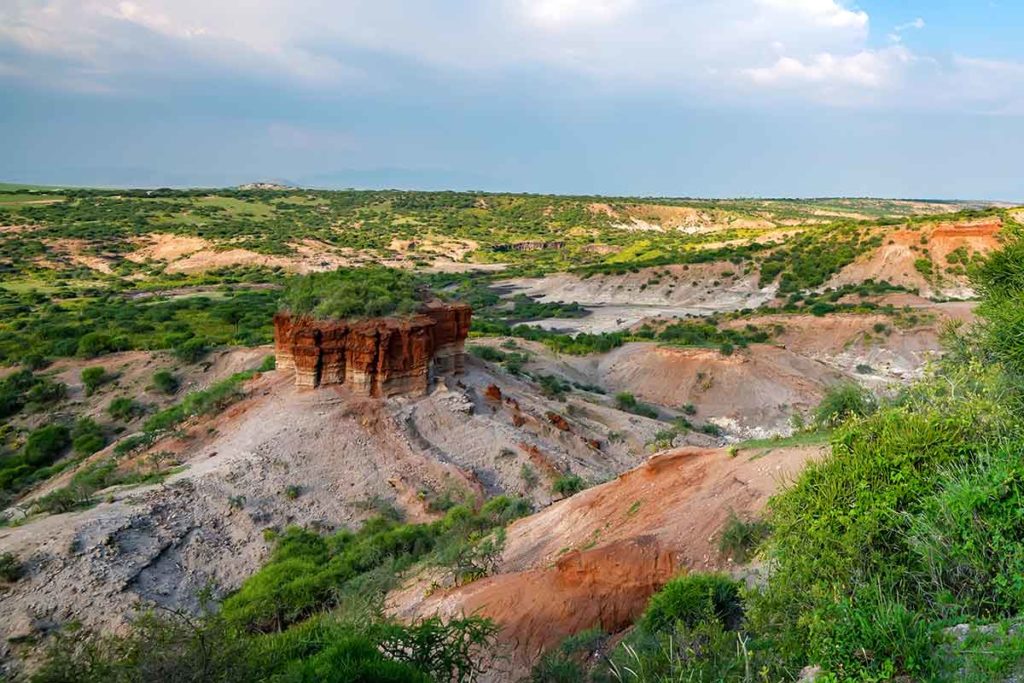
A powerful active volcano and a dangerous and challenging climb, Mount Nyiragongo holds one of the worlds largest lava lakes.
The lava crater, which is often only visible at night, is shrouded in clouds and mist during the day as smoke pours out of the volcano leaving the summit often obscured from view.
The mountain stands at 11,382 feet high, and last erupted in 2002.
Surprisingly, despite its volatile nature and dangerous climb up pathways formed from uneven and jagged volcanic rock, tours are run for visitors to scale the mountain and view the lava lake for themselves.
10- Skeleton Coast – Namibia
The Skeleton Coast in Namibia is a 500km stretch of coastline.
The weather conditions here are often unpredictable and have led to many boats becoming lost in storms and ending up shipwrecked on the beaches.
The name ‘Skeleton Coast’ does not come from the number of shipwrecks here but rather from the large number of whales who lost their lives on the beaches and whose skeletons litter the coastline.
As well as spectacular shipwrecks, desert elephants, desert lions and cape fur seals can be seen.
The animals rely on mist from the ocean for survival, as the land is rainless and hostile.
11- Mara River – Kenya
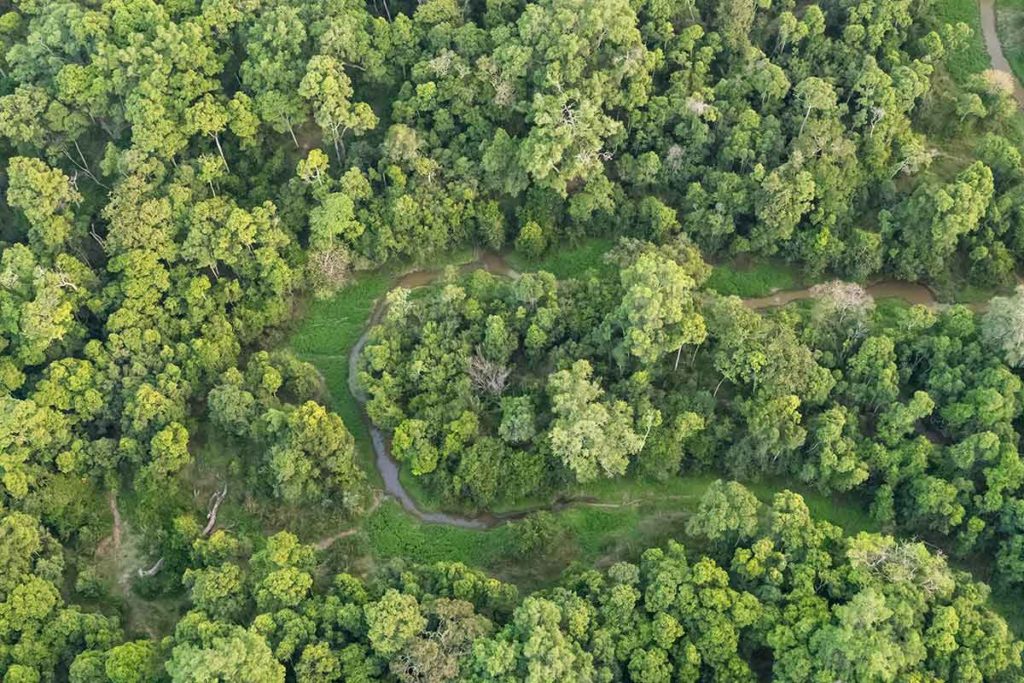
The Mara River in Kenya’s Masai Mara is home to one of the most incredible natural phenomena on earth: the great wildebeest migration.
The river is 395km long and feeds into Lake Victoria.
The river runs across the migration path of many African animals and as such, is a vital part of their habitats and migration patterns.
The wildebeest migration is one of the biggest tourist destinations in Kenya, attracting visitors to view hundreds of wildebeest crossing the Mara River in search of cooler climates and greater volumes of food.
Historic Landmarks in Africa
12- Lalibela Rock-Hewn Churches – Ethiopia
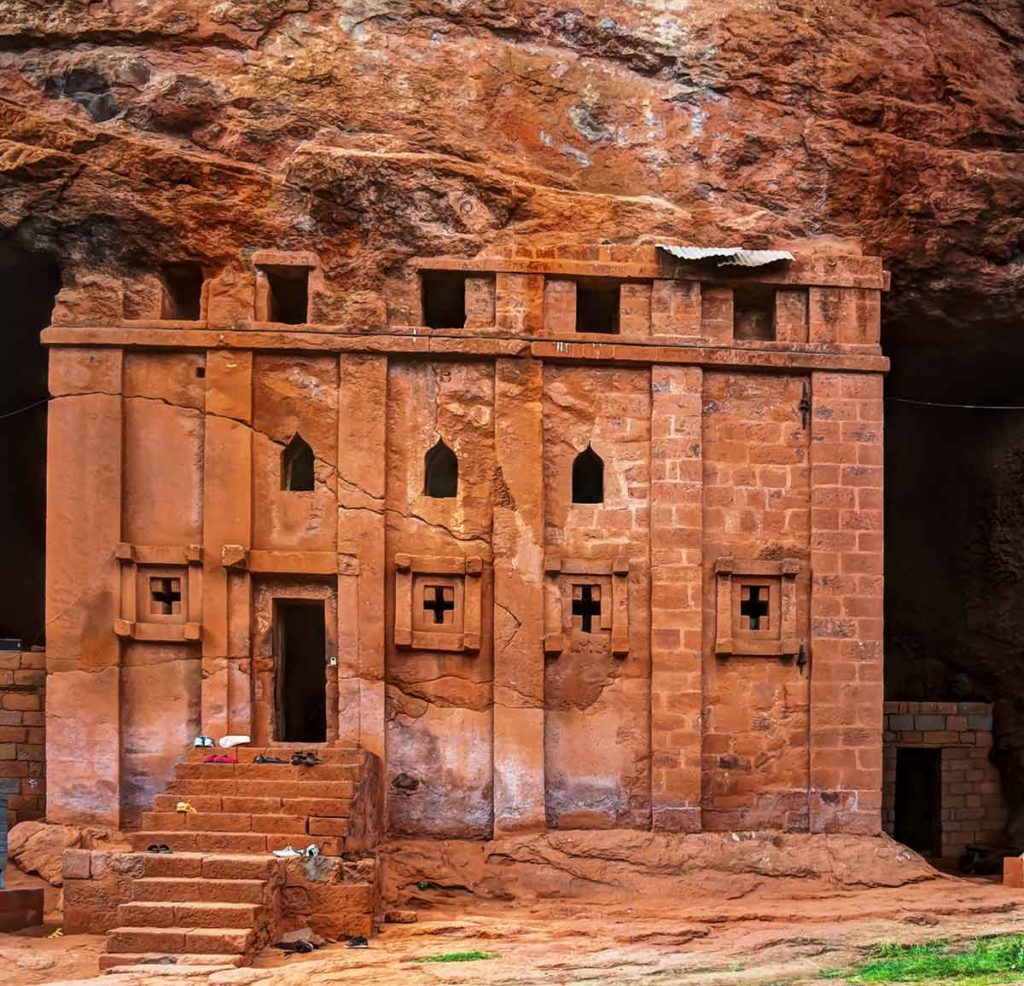
Deep within the mountains of Ethiopia lie 11 spectacular churches, not built brick by brick but carved out of the earth.
The churches date back to the 13th century, and the site still remains an important pilgrimage for Christians today.
The church’s unusual structure means that from ground level, only square or rectangular pits are visible.
The churches inside the pits were carved completely from singular stone ground and include detailing such as windows, columns, and floors.
The churches are still in use and are occupied by a small community of monks and priests.
13- Thebes – Egypt
Lying on both banks of the river Nile is Thebes, Ancient Egypt’s capital city during the 11th and 18th dynasties.
Thebes is brimming with artefacts, remnants of ancient structures and temples, and of course, intriguing and mysterious history.
Within Thebes are some of Ancient Egypt’s most important treasures, including the Valley of the Kings, with 65 tombs uncovered at present, the Tomb of King Tutankhamen, and Karnak Temple, the largest remaining religious site of the ancient world.
In 1979 Thebes was declared a UNESCO World Heritage Site, enabling this marvel of ancient culture to be preserved for future generations.
14- Volubilis – Morocco
An ancient Roman city in Morocco, the now-ruined city of Volubilis, was built during the 2nd and 3rd centuries.
The city today is remarkably well preserved, with columns standing and arches intact.
Intricate mosaics which were once floors of grand homes are still whole and visible.
Despite the fall of the Roman Empire, the destruction of the churches during the introduction of Islam, and residents simply leaving to move to new cities, Volubilis remained occupied until an earthquake devastated much of the area in the 18th century.
Volubilis has been excavated since the 1830s and was made a UNESCO World Heritage Site in 1997.
15- El Jem – Tunisia
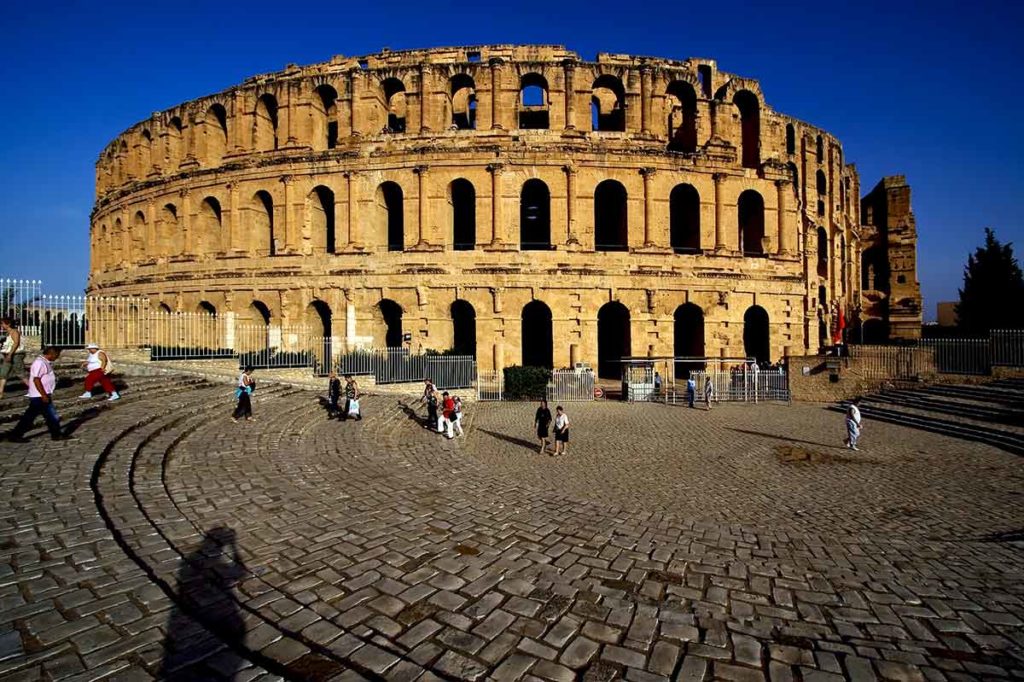
Another spectacular example of Roman architecture in Africa is El Jem, a colosseum in Tunisia which was the second-largest during the Roman period, following the Rome colosseum.
The colosseum was built entirely from stone blocks without foundations, and much still stands intact today, including arched windows, entrances and tiered seating.
It is believed that the colosseum dates from around AD230 for soon-to-be emperor Gordian.
Despite its age and historical significance, visitors are permitted inside this ancient structure and can even climb to the top of the tiered seating for views over the whole colosseum and surrounding area.
More Landmarks in Asia:
16- Leptis Magna – Libya
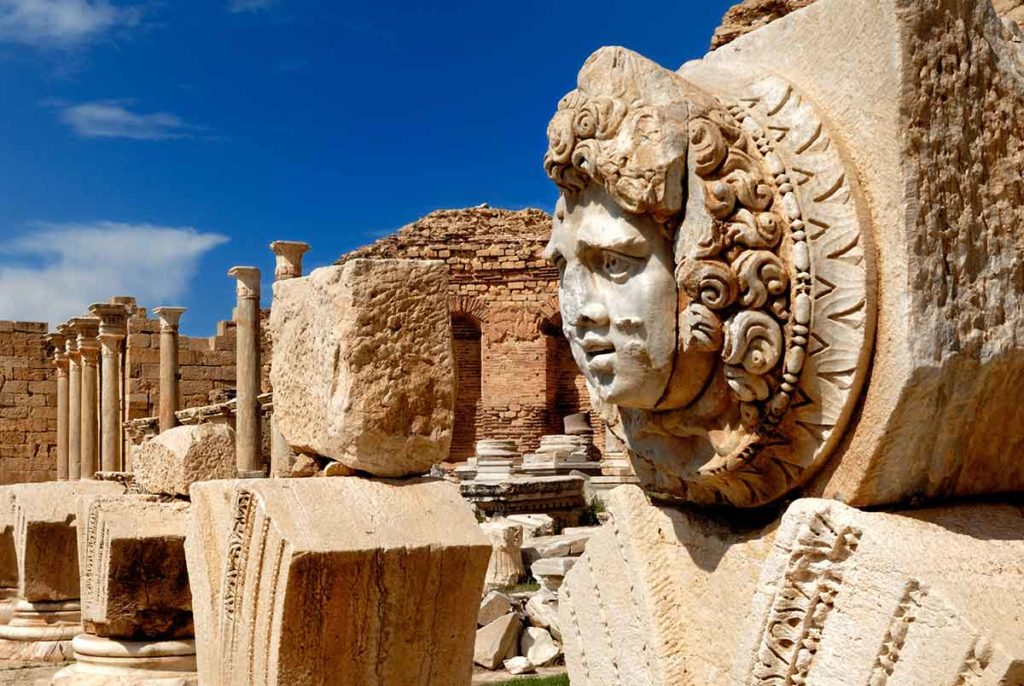
Often referred to as one of the most beautiful cities in the Roman Empire, Leptis Magna in Libya is a salient and partially intact Roman city.
The city was the birthplace of Roman Emperor Septimius Severus, who developed and enhanced the city during his lifetime.
The ruins include a theatre, forum and Tetrapylon arch.
Dams and canals were constructed throughout and around the city to ensure the city was safe from the regular flooding of the Wadi Lebda river.
Following centuries of abandonment, war and a reduction in the size of the city, excavations first began during the 1920s, with the aim of uncovering Roman treasures hidden in the sand.
17- Timbuktu – Mali
For centuries, the striking towers of Timbuktu were a seat of religious and scholarly importance.
During the 13th to 16th centuries, Timbuktu acted as an education hub to spread the word of Islam across Africa.
The importance of education in Islam here was recognised by scholars from across Africa and beyond and aimed to enlighten them in Islam, as well as astronomy, law and mathematics.
Much of Timbuktu still stands today, albeit appearing a little rundown.
Sadly many of the written records detailing African history from Timbuktu’s educational heyday are in very delicate states and so remain sealed away from tourists.
18- Pyramids of Meroe – Sudan
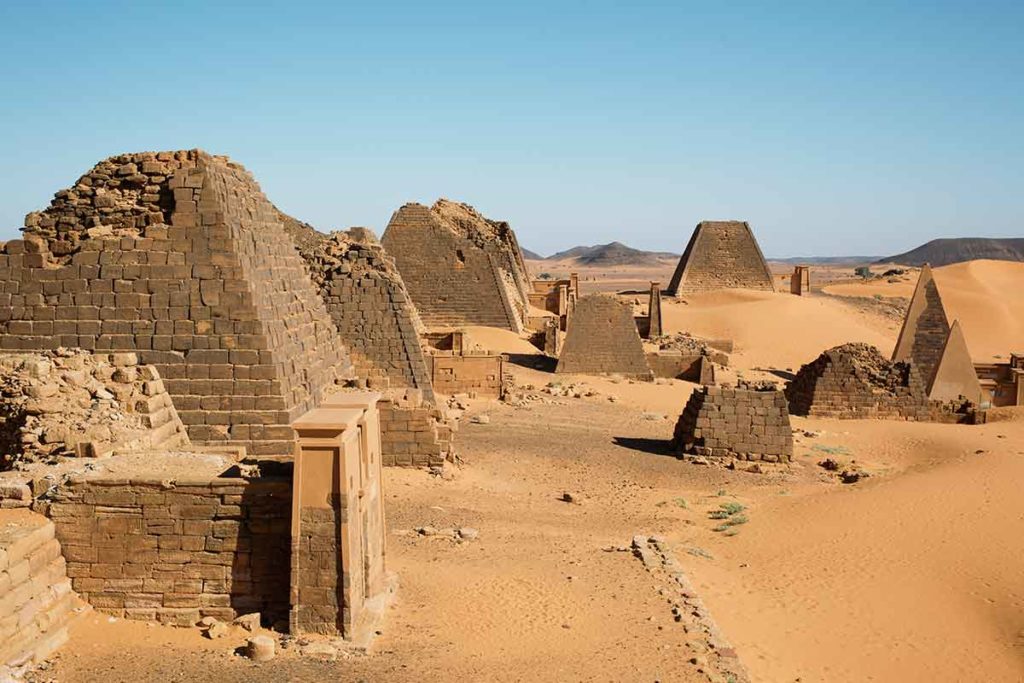
Further down the River Nile than the grand Great Pyramids of Giza stands a collection of nearly 200 ancient pyramids; the Pyramids of Meroe in Sudan.
The pyramids are mostly tombs for royalty from the Meroitic Kingdom that ruled for over 900 years.
The pyramids date from 2300 to 2700 years ago and feature elements of decoration and engineering design from Ancient Egypt, Rome and Greece.
The pyramids are steeper in design than those found in Egypt and feature grand entranceways, some of which have been reconstructed.
19- Canopy Walk – Rwanda
Located in the spectacular rainforest environment of the Nyungwe National Park, the Canopy Walkway is suspended above a thick leafy ravine.
The walkway is 70m high and stretches across 160m.
Due to the nature of the surrounding area, the bridge is only accessible as part of a guided tour or if hiking on either the Imbaraga or Umuyove trails.
The walk through the park to the canopy walkway offers sightings of rare butterflies, orchids and colourful birds native to the area.
Many primates live in the national park, and their activity can often be seen from the walkway.
Primate tracking walks are available for chance encounters with primates such as gorillas, baboons and bushbabies.
20- Great Zimbabwe Ruins – Zimbabwe
Constructed between the 11th and 14th centuries, Great Zimbabwe was an incredible structure, consisting of housing, enclosures, large buildings and a high wall protecting its inhabitants.
Sadly when the city, uninhabited at the time of its discovery by foreigners in 1531, was visited by a Portuguese sea captain, it was plundered for its gold.
The sea captain believed that no indigenous African could have built such an impressive and colossal structure.
It was this that lead to Great Zimbabwe falling into even greater disrepair and neglect.
In 1929, a team of British archeologists uncovered evidence that the immense structure was built by local Bantu peoples.
The buildings were constructed of granite and were embellished with elegant stairways, decorations, turrets and towers.
Read more about Africa here:
- 20 Famous Landmarks in Africa
- Masai Mara Safari in Kenya
- Things To Do In Nairobi
- Things To Do In Mombasa
- Mount Kenya Safari Club
- Fairmont The Norfolk
- Glamping in Africa
- 18 Things To Do In Seychelles
- Climbing Mount Kilimanjaro
- 20 Moroccan Cities
- 20 Things To Do In Agadir
- 20 Things To Do In Casablanca
- 20 Things To Do In Fez
- 20 Things To Do In Tangier
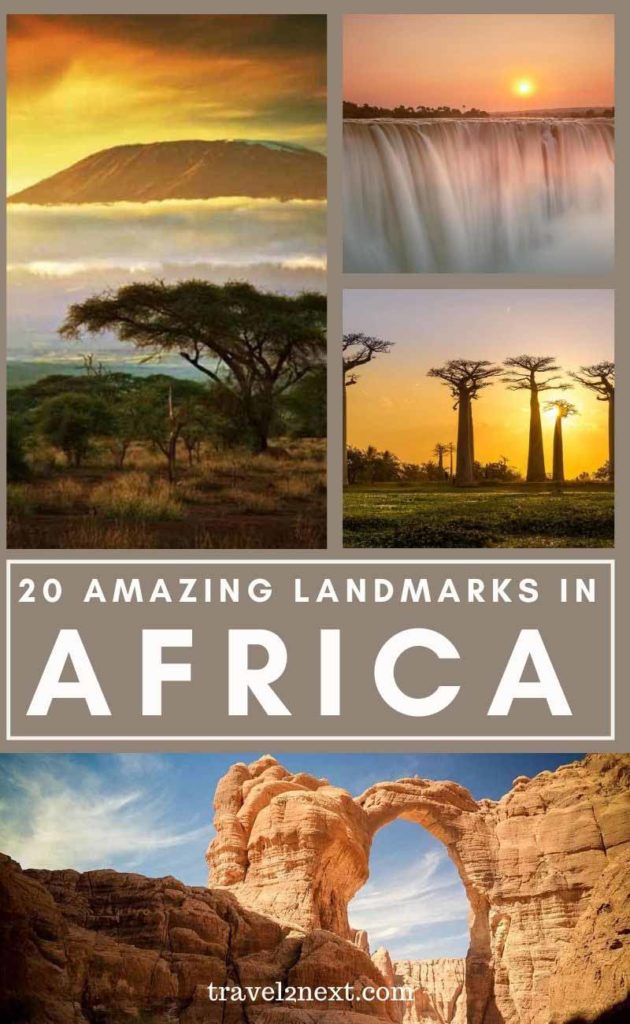

Plan Your Trip

Rent A Car – Find the best car rental rates at Discover Cars. They compare car hire companies to provide you with the best deal right now.

Find A Hotel – If you’re curious about this article and are looking for somewhere to stay, take a look at these amazing hotels.

